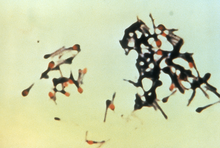Clostridium tetani
| Clostridium tetani | |
|---|---|
 |
|
| Clostridium tetani with characteristic 'tennis racket' appearance. | |
| Scientific classification | |
| Domain: | Bacteria |
| Phylum: | Firmicutes |
| Class: | Clostridia |
| Order: | Clostridiales |
| Family: | Clostridiaceae |
| Genus: | Clostridium |
| Species: | C. tetani |
| Binomial name | |
|
Clostridium tetani Flügge, 1881 |
|
Clostridium tetani is a rod-shaped, anaerobic species of pathogenic bacteria, of the genus Clostridium. Like other Clostridium genus species, it is Gram-positive, and its appearance on a gram stain resembles tennis rackets or drumsticks.C. tetani is found as spores in soil or in the gastrointestinal tract of animals. C. tetani produces a potent biological toxin, tetanospasmin, and is the causative agent of tetanus, a disease characterized by painful muscular spasms that can lead to respiratory failure and, in up to 10% of cases, death.
Tetanus was known to ancient people, who recognized the relationship between wounds and fatal muscle spasms. In 1884, Arthur Nicolaier isolated the strychnine-like toxin of tetanus from free-living, anaerobic soil bacteria. The etiology of the disease was further elucidated in 1890 by Antonio Carle and Giorgio Rattone, who demonstrated the transmissibility of tetanus for the first time. They produced tetanus in rabbits by injecting their sciatic nerve with pus from a fatal human tetanus case in that same year. In 1889, C. tetani was isolated from a human victim, by Kitasato Shibasaburō, who later showed that the organism could produce disease when injected into animals, and that the toxin could be neutralized by specific antibodies. In 1897, Edmond Nocard showed that tetanus antitoxin induced passive immunity in humans, and could be used for prophylaxis and treatment. Tetanus toxoid vaccine was developed by P. Descombey in 1924, and was widely used to prevent tetanus induced by battle wounds during World War II.
...
Wikipedia
